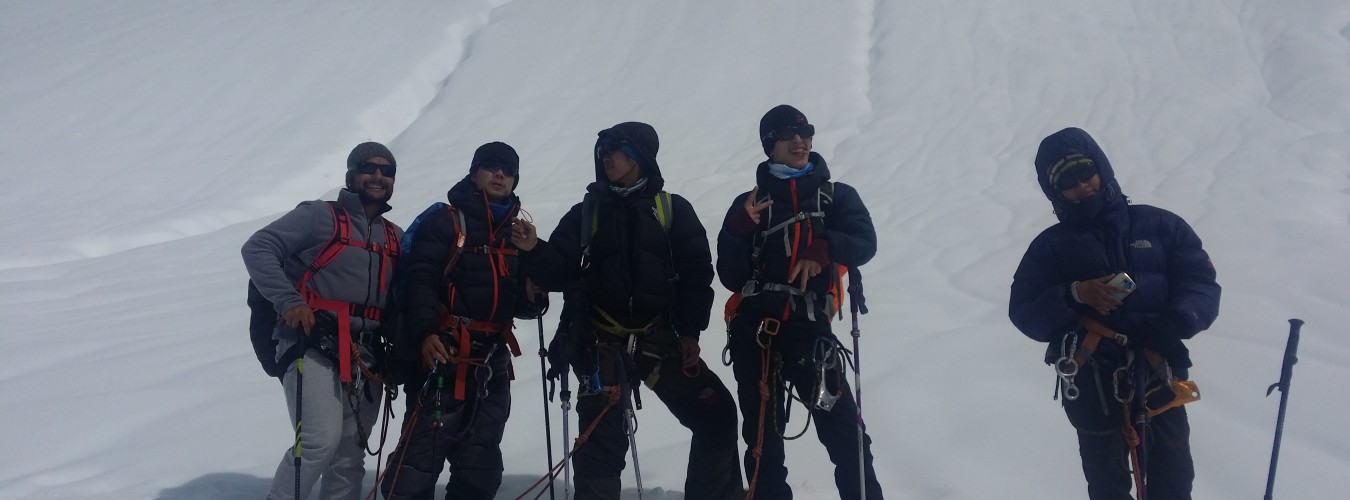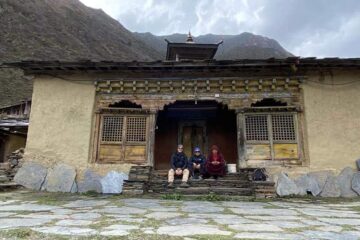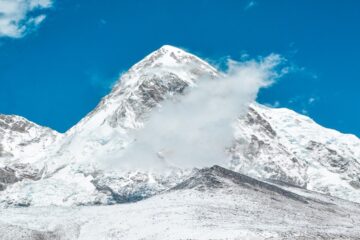Conquering an island of snow in the Himalayas is obviously a fun-filled escapade with unlimited thrills, sheer adventure, and treasured memories.
lsand Peak climbing Imje Tse, also known as Island Peak is popular among climbers because of its beauty, which looks like the island of ice on the elevated region ringed by Himalayas. Fascinating and great climbing peak in the center of Khumbu Himalayas, Island Peak soars as high as 6,189m. It is an ideal peak to begin the Himalayan adventure of climbing and the challenges to conquer this beautiful mountain are considered moderate.
Our Island Peak climbing trip starting from Chukkung fulfills the dream of every amateur and serious climbers, who have been seeking the thrill of adventure and wish to take adventure climbing trips beyond simply trekking in Everest.
Outline Itinerary:
Day 01: Meet our Climbing Guide at Chhukung and trip briefing.
Day 02: Chhukung -Island Peak Base camp (5,200m/17,060ft), 3-4 hours
Day 03: Island Peak Base Camp to High Camp (5,600m/18,372ft), 2-3 hours
Day 04: High camp to summit (6,189m/20,305ft) to Chhukung, 8-10 hours
Day 1: Meeting our Climbing Guide at Chhukung and trip briefing (Altitude: 4700m)+
Till Chukkung, you will be trekking at your own. Our Climbing Guide will be waiting you at the Chukkung- from where you will officially enter to the Imja Valley. Our climbing guide will meet you and brief you about the Island peak and climbing. He will check all your trekking gears and equipment and help you to even hire the gears for the peak climbing. Remaining time explore yourself and overnight at lodge in Chukkung.
Day 2: Trek from Chhukung to Island Peak Base camp (Altitude: 5,200m; Trek: 3-4 hrs. climbing; Meal: BLD)+
Today after the breakfast, our Island Peak Climbing Adventure begins. We exit out of the village and climb steeply up to the south turn east to enter the main trail into Chhukkung Valley. Continue short pleasant walking along a streamside that leads to the Big –rock. At this point, the route to the Amphu Lapcha Pass stretches on the southeast direction; however, we tread the trail on the north. A moderately challenging trail cross Imja and Lhotse glacier moraines that leads you to a wide valley flanking Island peak where we will set up our base camp for overnight at tented camp.
Day 3: Climbing from Island Peak Base Camp to High Camp (Altitude: 5600m; Trek: 2-3 hrs. Meal: BLD)+
You will starts to climb the high camp in the morning. Hence, get ready with the camping stuffs and kick up towards the High camp from where our Island peak Climbing will start. As you climb up, you can be getting narrow slopes and the path enters a steep rock channel nearby where we will fixed the camp. Guide will fix crampons on your climbing boots and re-check the entire climbing group and personal equipment once again for better safety. If required, you may learn last minute climbing technique with our climbing Sherpa at this stage. If possible, you will be also taken for the ice/rock climbing nearby but subject to the availability. Overnight at High Camp
Day 4: High camp to summit to Chhukung (Altitude: 6189m; Trek: 9/10 hrs.; Meal: BLD)+
Island Peak Ascent (6,189m/20,305ft) starts early this morning via climb to the rock gully. This is not difficult but there are several short rock steps to climb before you emerge on the right side of the gully. The route then follows a ridgeline, which leads to an exhilarating and exposed traverse onto the snout of the summit glacier. You will need to rope up for the glacier as it contains several crevasses but it leads without difficulty, to a 100m(330ft) snow and ice slope (40-45 Degree) on which the guides will fix a rope. From the top of this slope, 3 rope lengths along a sharp summit ridge lead to the top. After enjoying the summit views you will descend all the way to Chhukung for overnight.
Service Includes:
Island Peak Climbing guided by our Experienced licensed holder Climbing Sherpa
Island Peak Climbing Permit
Group climbing gear/equipment- Main rope, fix rope, Ice crew
Hiring charge for personal climbing gears
02 Nights/ 3 Days camping accommodation with all meals
All the expenses of Climbing Sherpa/ Assistant Climbing Sherpa and porters.
High Altitude Climbing Insurance that includes Heli rescue, medical and personal accident of our climbing staff
All applicable Government and Local Taxes
Oxygen Gas or Gammo Bag (can be provided on request with additional cost)
Service Excludes:
Any Airfare
Trek before climbing Island peak (if you wish, shall organize)
Kathmandu Accommodation and Services
Travel Insurance (should cover the policies- medical expenses, heli evacuations and rescues)
Tips for Guide, porters…
Anything not included in “Service Includes”
Travel Insurance
While travelling to Nepal, you are requested to have a travel insurance that should cover any comprehensive expenses possible to acquire due to medical issues or accidents. Especially, your travel insurance must protect air ambulance, treatment charges, rescue and evacuation, product cancellation and refundable charges, flight delay and cancellations. We suggest you to bring you travel insurance certificate or send us scan copy and required to issue from your home land and we do not arrange or sell insurance. Travelling in the Himalayas is full of adventurous; hence it is wise to choose a proper insurance policy. While choosing your insurance policy, make sure that it will protect all such unforeseen expenses. Your insurer should be well familiar with our itinerary that you have booked and must have agreed to cover all activities being undertaken during trip. Meantime, it is not compulsory that our all the assigned trip are facilities with Heli-rescue. You will not require heli rescue insurance for Tibet Tour as it is not possible to provide such facility.
Vaccination
It is better to follow the precaution given by World Health Organization and other international health related institutions that recommend having vaccines before travelling Nepal to prevent from certain fatal illness. If possible, we suggest you to bring your medical certificate however, it is not required to show but for safety. The recommended vaccines are polio, Diphtheria, Tetanus, typhoid, yellow fever, hepatitis A/B, Influenza (Flu), Japanese encephalitis, and Tuberculosis. Meantime, it is better to consult your professional doctor about your travel and he might recommend you properly. You can also take suggestion of local travelers who have travelled Nepal before and know more about the required precautions. Please note that the protection that can be gained from vaccines varies from 50% to almost 100%. So remember that even if you have taken a vaccine you might still get the disease, although you will have greatly reduced your chances of getting ill.
Health and Fitness
While Trekking in the Himalayas of Nepal, you will be hiking up in high altitude, hence slow and steady is main concern which helps you to acclimatize properly with the altitude. During trekking, you will required to walk for 5-6 hours in average. If you are planning to trek in Nepal, make sure that you are in good shape and fitness, and consult your doctor or general physicians about your health. You should be physically and mentally prepared. Before commencing a trek, we recommend you to do some regular exercises, make habits to use stairs than elevator that makes your knees strong, and, if possible, join some aerobics, gyms and make sure about your good health. If you are used to with these habits, you will definitely walk in the Himalayas of Nepal. Sincere preparation and strong determination for the trip is very important making your trip a wonderful memory of your life. It is not compulsory to have any previous experience. Follow the guidance and enjoy the trip.
High Altitude Sickness
At the higher altitude, you will feel a decrease in availability of oxygen and shorten in oxygen cause an altitude sickness. If a person walk in the high altitude particularly climbs up too quickly, he might suffer from High altitude sickness. Hence, proper rest is required at that altitude. You can cure at right time knowing certain symptoms of Altitude Sickness. Common symptoms are headache, loss of appetite, tiredness and nausea, vomiting, dizziness and difficulty in sleeping. The best remedies that local belief and take is taking garlic, or ginger in mouth. Eat dry food and take liquid as much as possible. We recommend Diamox if there is no any options. Also, we provide experienced guide and staffs in dealing with the effects of higher altitudes. As they are natives of Nepal, they easily acclimatize and therefore can care for their clients. They are equipped with necessary medical supplies and will assist with basic first aid treatment. We design our tours to ensure clients are ready for high altitude, and arrange alternative itineraries for those at risk
Acclimatization
While, trekking in the Himalayas, you will walk in the Ups down trail taking you to the elevation over 2500 m. Hence, you might feel difficult to breathe or your breathe speed up. Hence, it is most important to familiarize with the altitude and let you adjust with the decreased availability of oxygen at high altitude. Our itinerary is designed with sufficient days to acclimatize. In case of gaining certain height, there is a rest day when you can explore the area as well as walk to high altitude and sleep at low land. Likewise, you are suggested to walk slowly and carefully without getting any stresses. Also, for proper acclimatization, you should care about your eating habits. Don’t focus on Junk food and eat as much liquid as possible. Hard drinks are not recommended. The right way to acclimatize properly is walk high, sleep low.
Diamox (Acetazolamide)
Diamox, a mostly recognized drugs for altitude sickness prevention and treatment. It allows you to breathe faster so that you metabolize more oxygen, thereby minimizing the symptoms caused by poor oxygenation. This is especially helpful at night when respiratory drive is decreased. While using a Diamox, it is advisable to start taking it 24 hours before you go to altitude and continue for at least five days at higher altitude. The recommendation of the Himalayan Rescue Association Medical Clinic is 125 mg. twice a day (morning and night). (The standard dose was 250 mg. but their research showed no difference for most people with the lower dose, although some individuals may need 250 mg.) Possible side effects include tingling of the lips and finger tips, blurring of vision, and alteration of taste. These side effects may be reduced with the 125 mg. dose. Side effects subside when the drug is stopped. It is more appropriate to contact your physician for a prescription. Since Diamox is a sulfonamide drug, people who are allergic to sulfa drugs should not take Diamox. Diamox has also been known to cause severe allergic reactions to people with no previous history of Diamox or sulfa allergies. Frank Hubbell of SOLO recommends a trial course of the drug before going to a remote location where a severe allergic reaction could prove difficult to treat.
Highly recommended to take a trial course before going to a remote location where a severe allergic reaction could prove difficult to treat if it occurred.
Alternative Drugs:
Dexamethasone (a steroid) is also a prescribed drug that decreases brain and other swelling reversing the effects of AMS. The dose is typically 4 mg twice a day for a few days starting with the ascent. This prevents most of the symptoms of altitude illness from developing.
ADVICE: Dexamethasone is a powerful drug and should be used with caution and only on the advice of a physician and should only be used to aid acclimatization by sufficiently qualified persons or those with the necessary experience of its use.
NOTE: It is more advisable to take drugs taking proper suggestions from Personal Physicians and in case if there is no any options. In the Himalayas of Nepal, the mountain dwellers believe in taking some garlic or ginger along with Red Pepper to produce heat for fast breathings.
| Start Date | Trip Price | Action |
|---|







Tour Reviews
There are no reviews yet.
Leave a Review